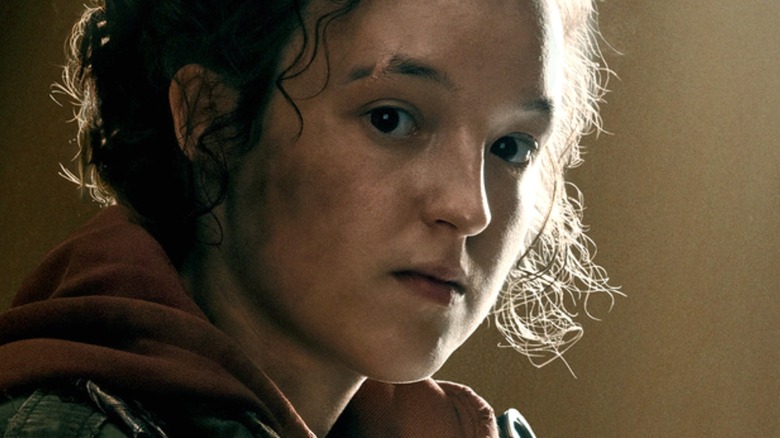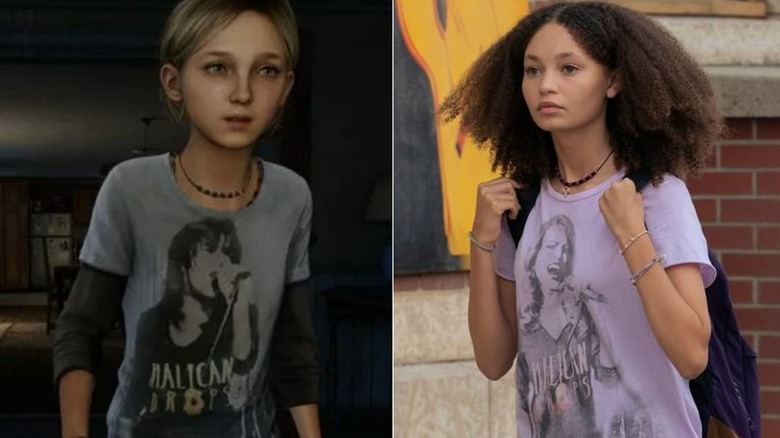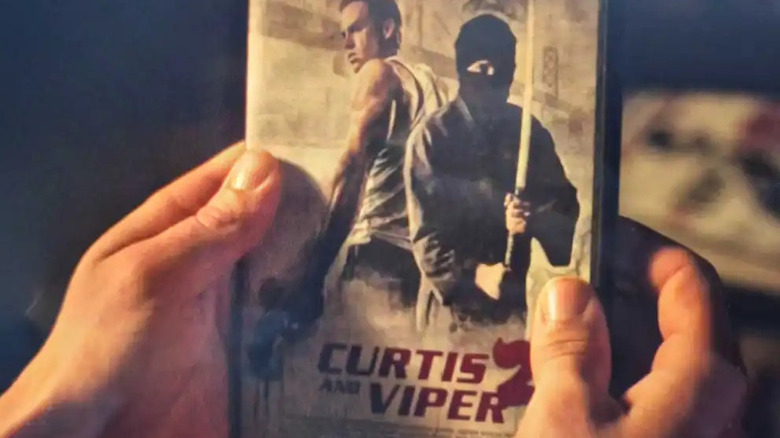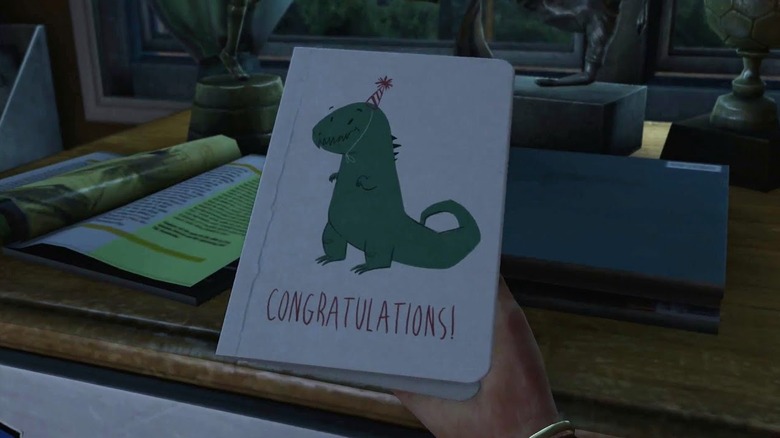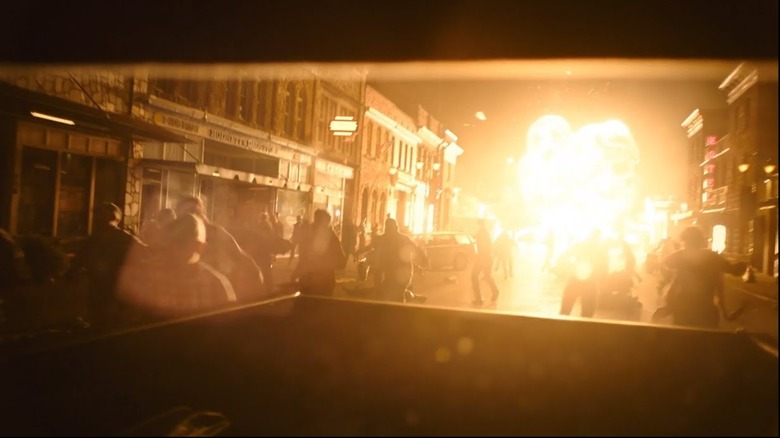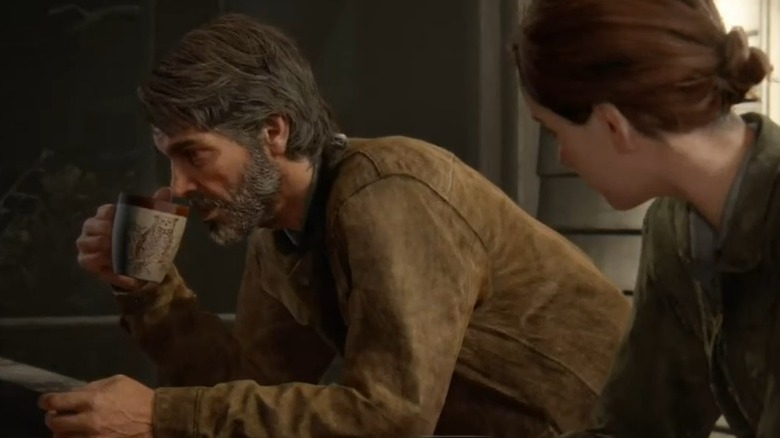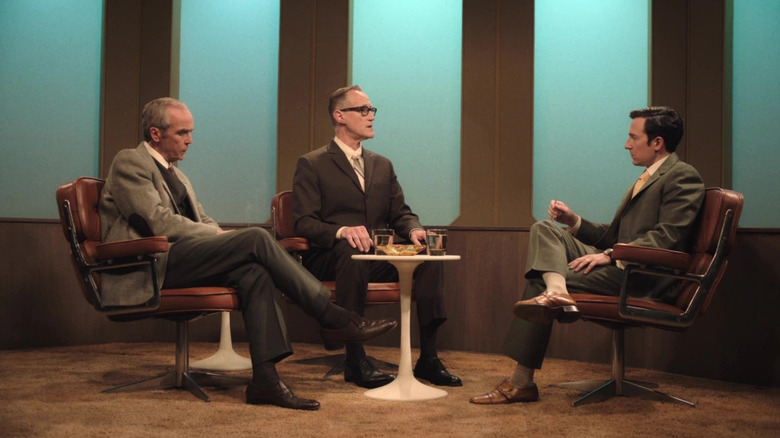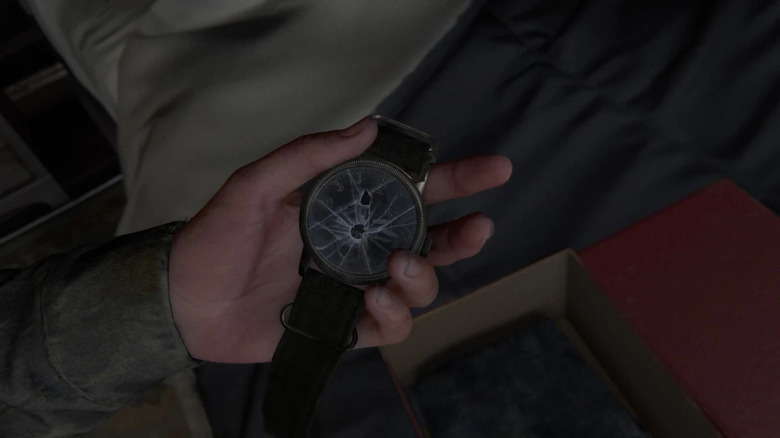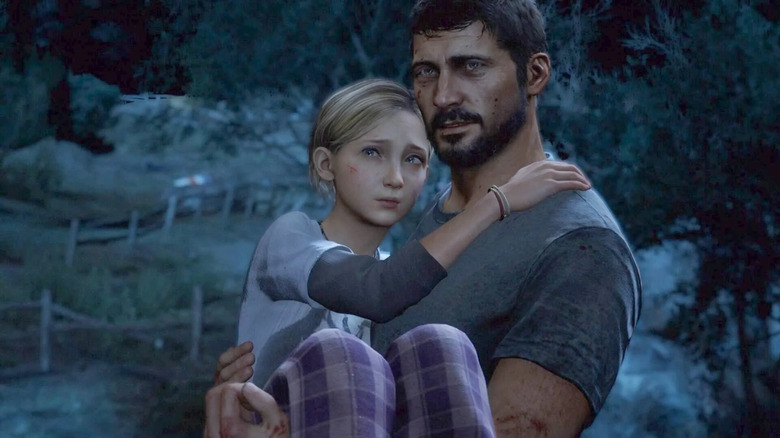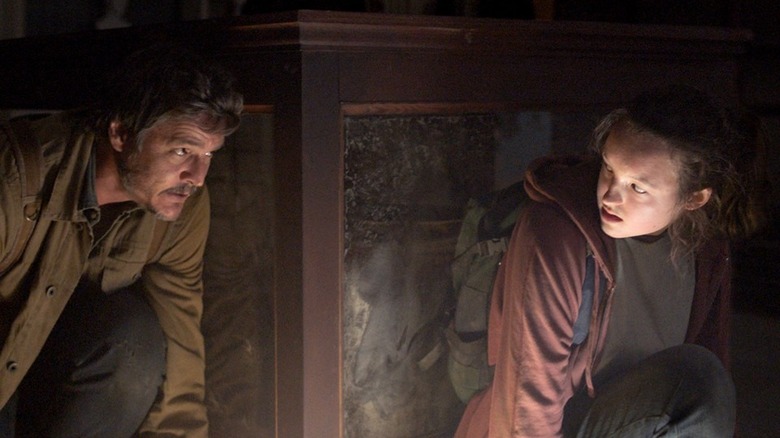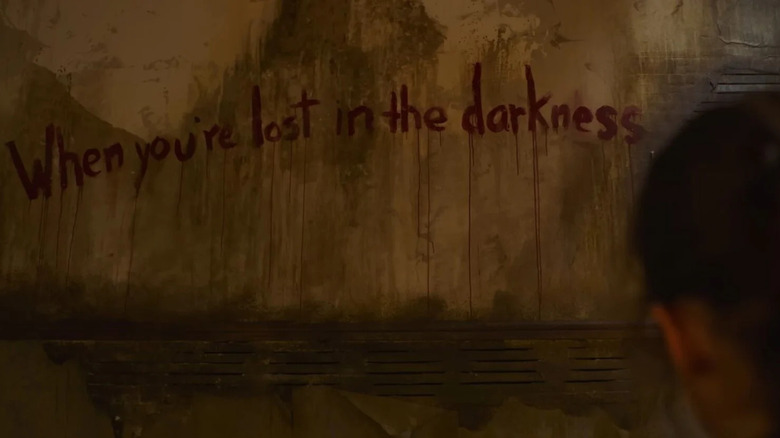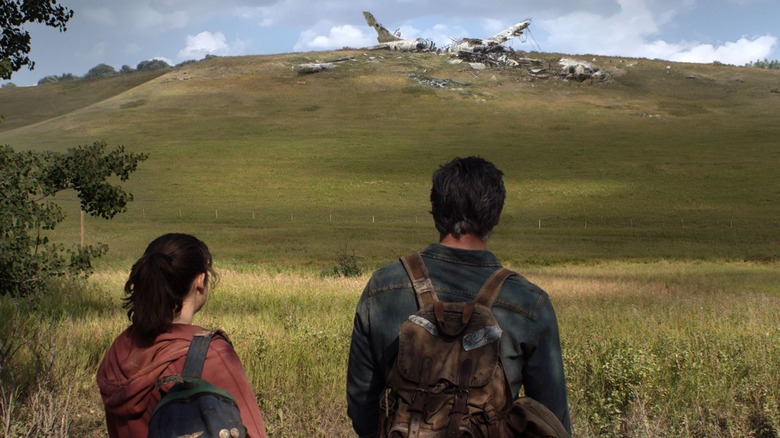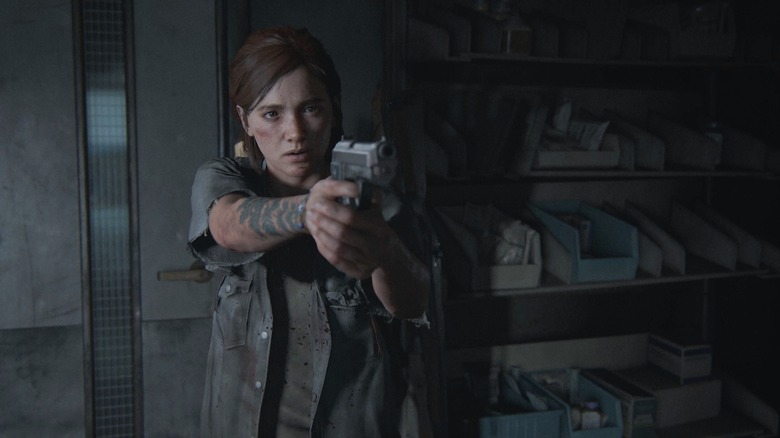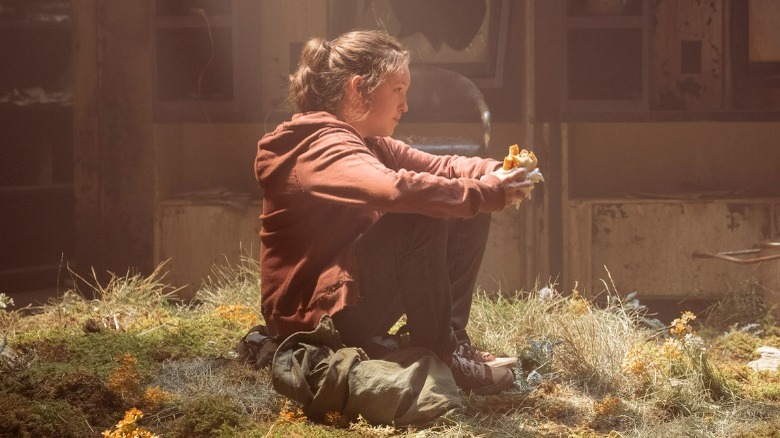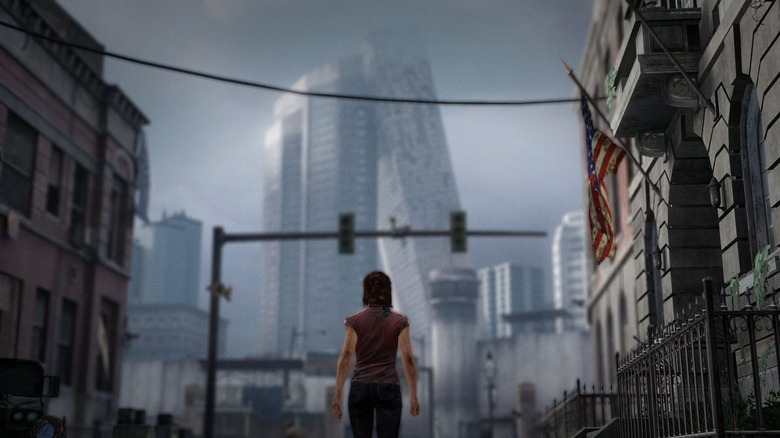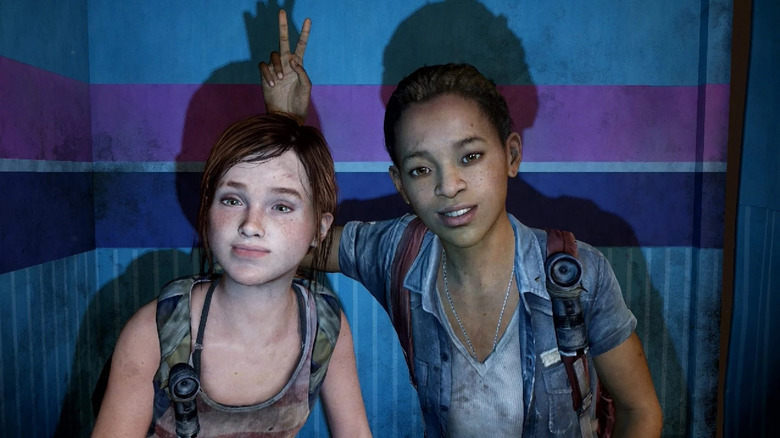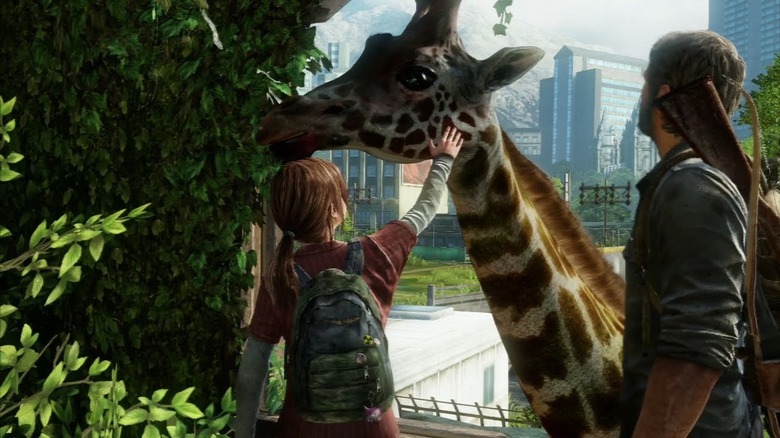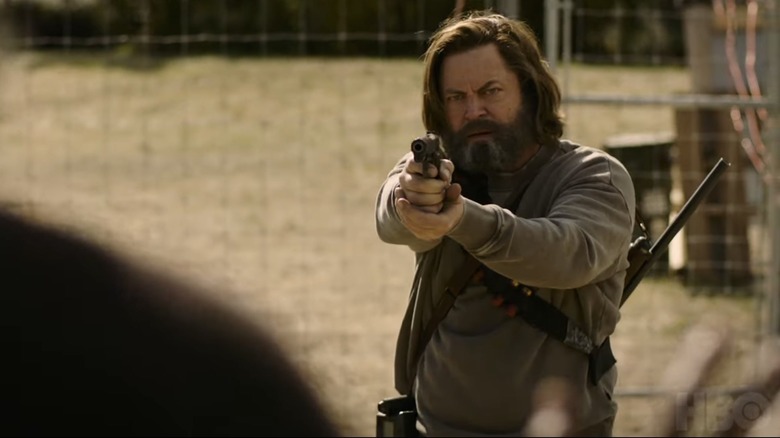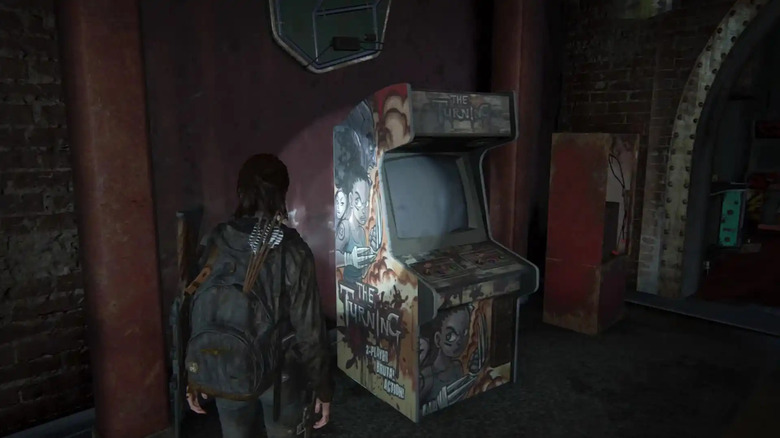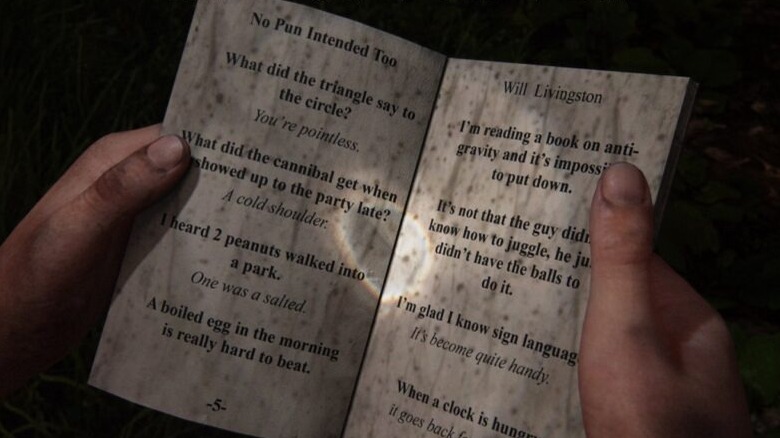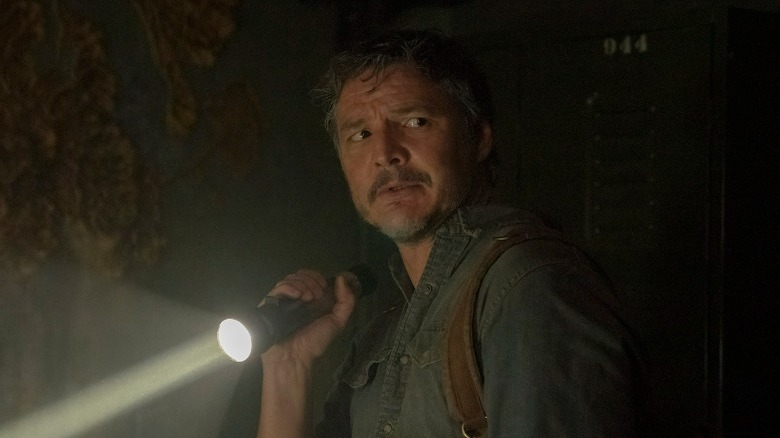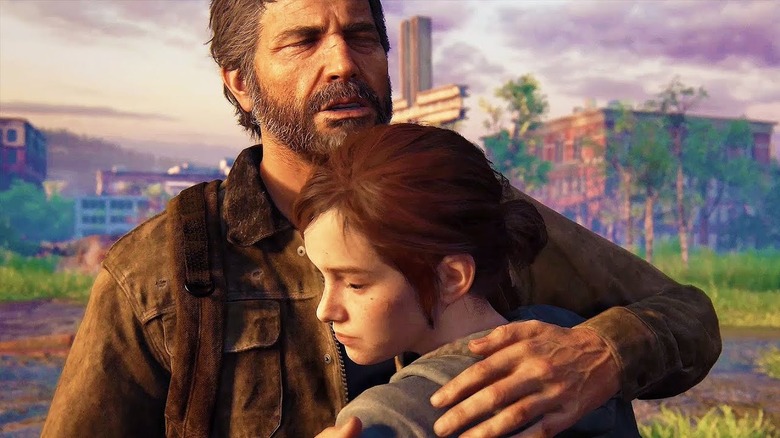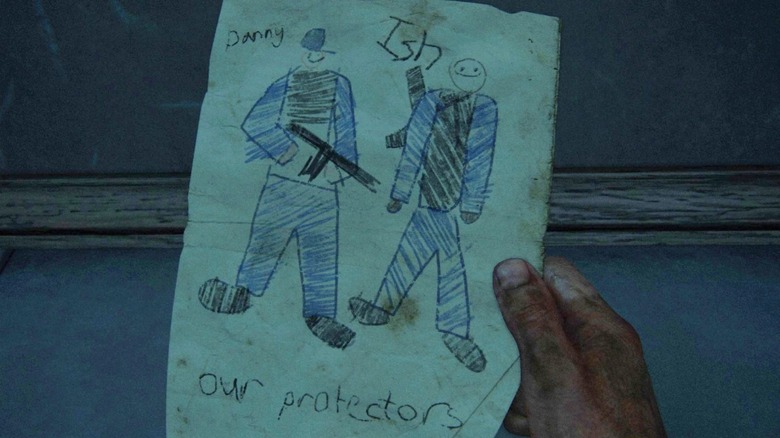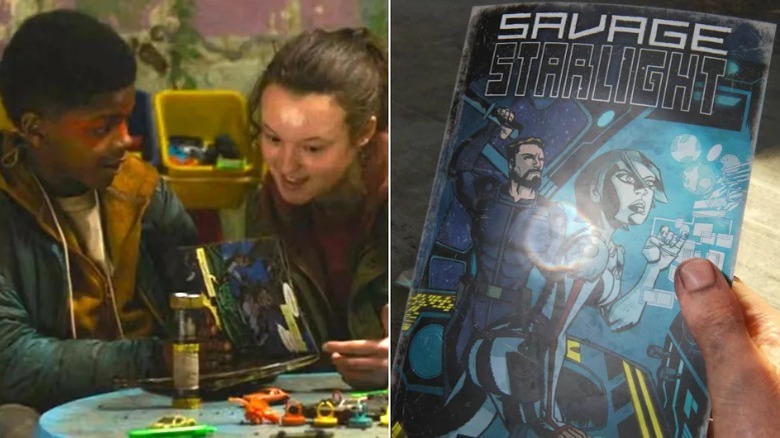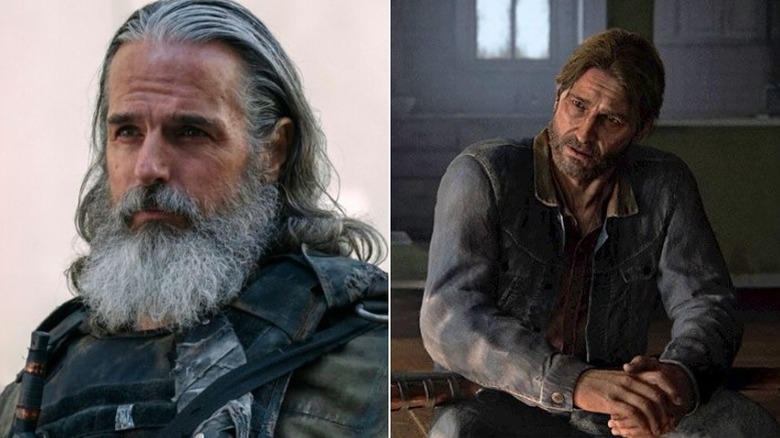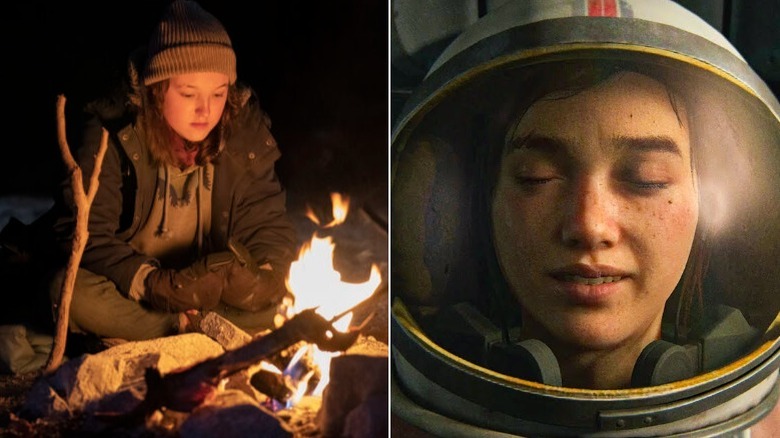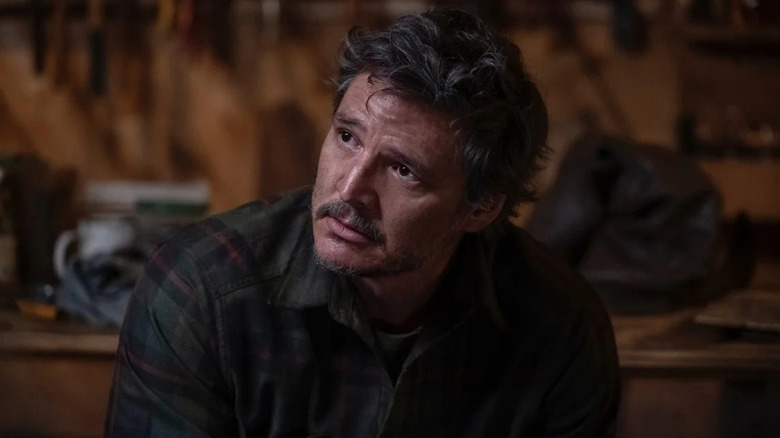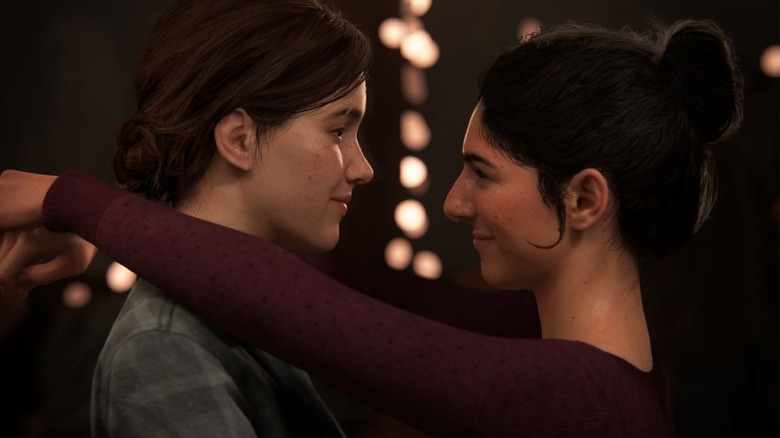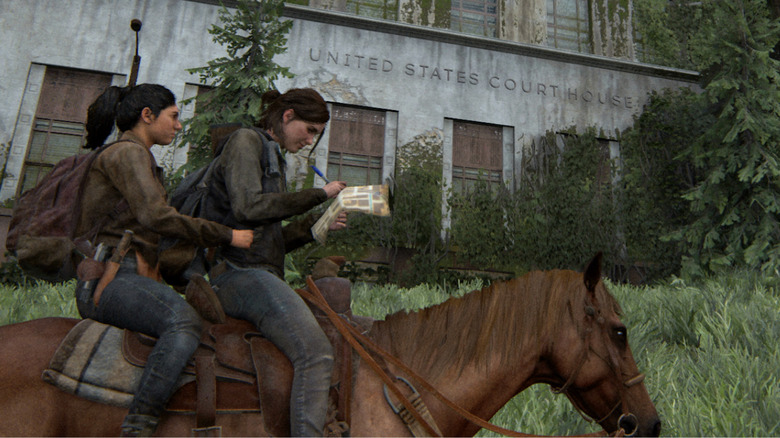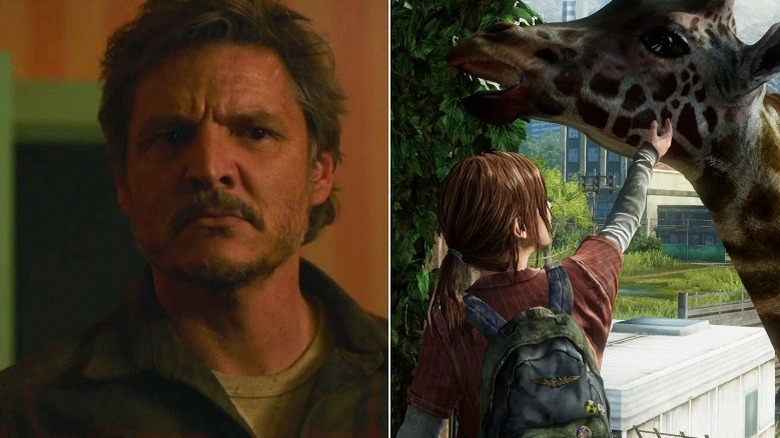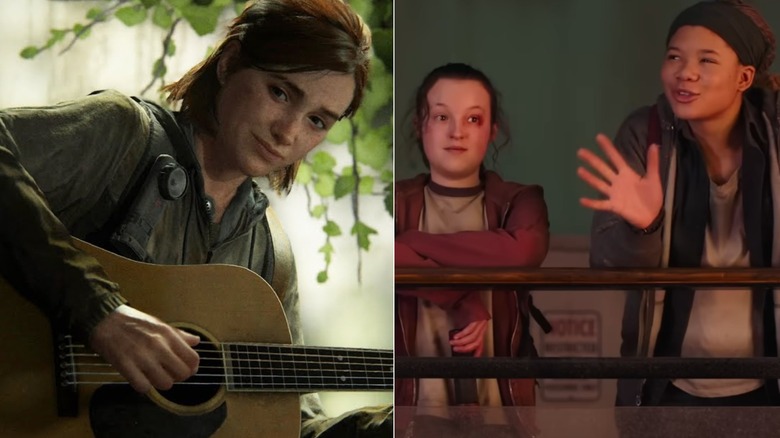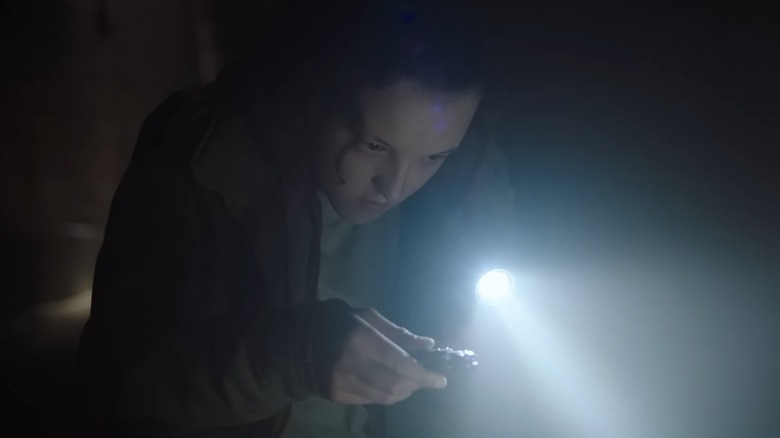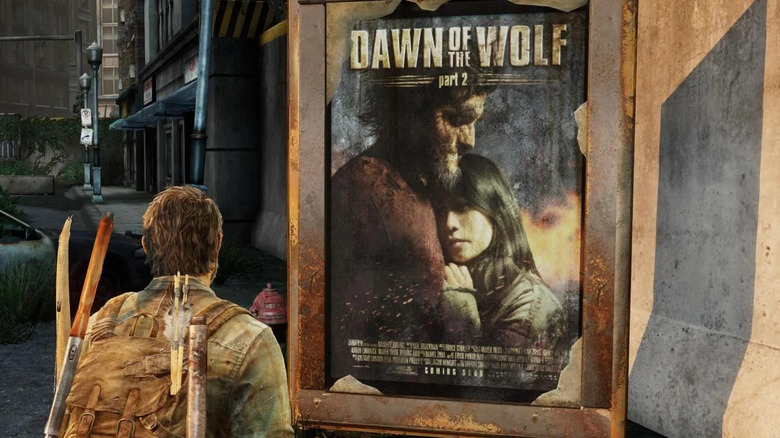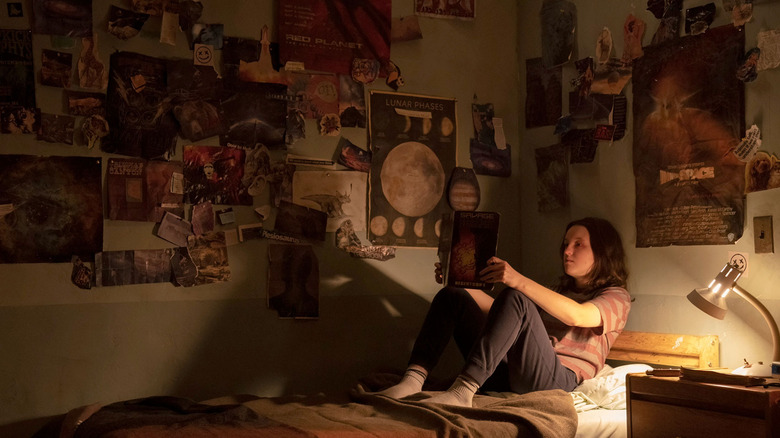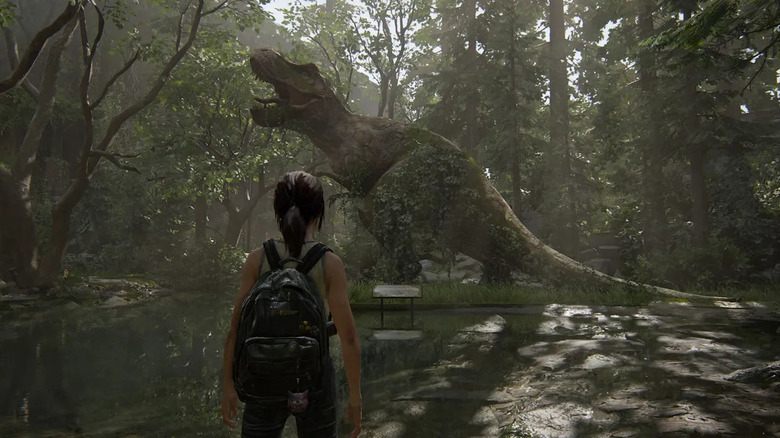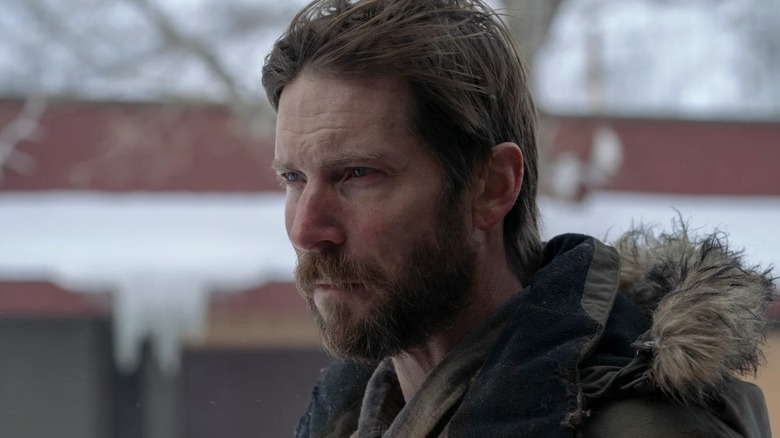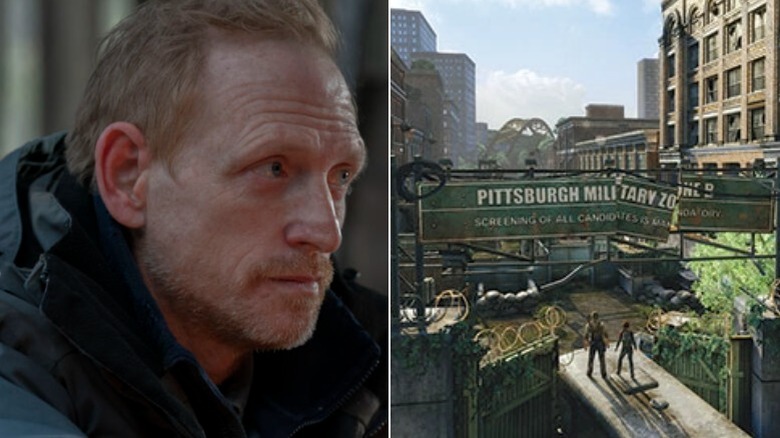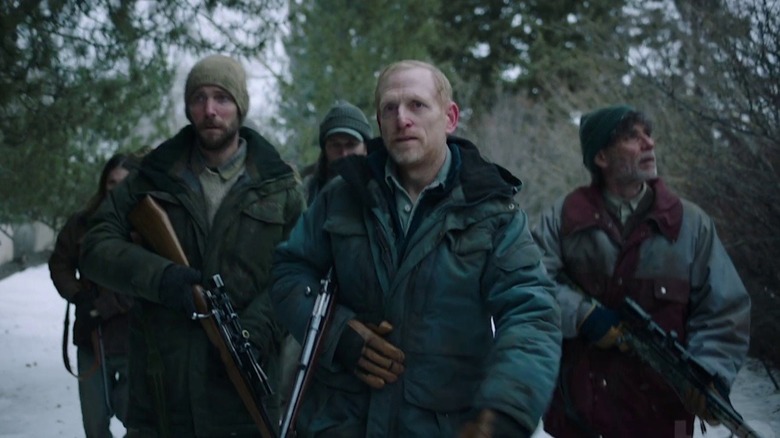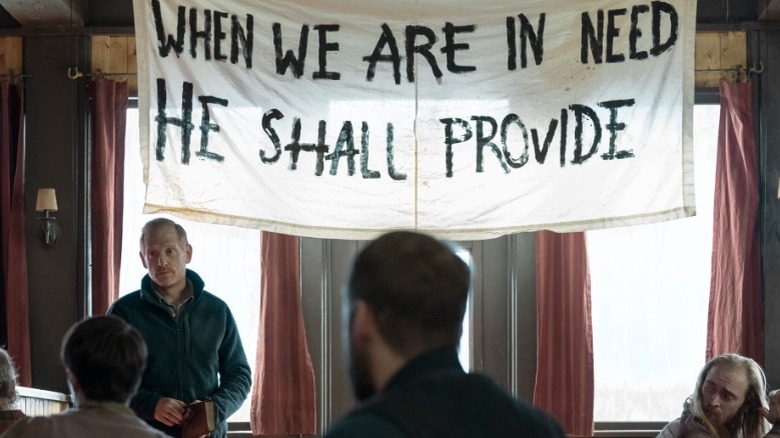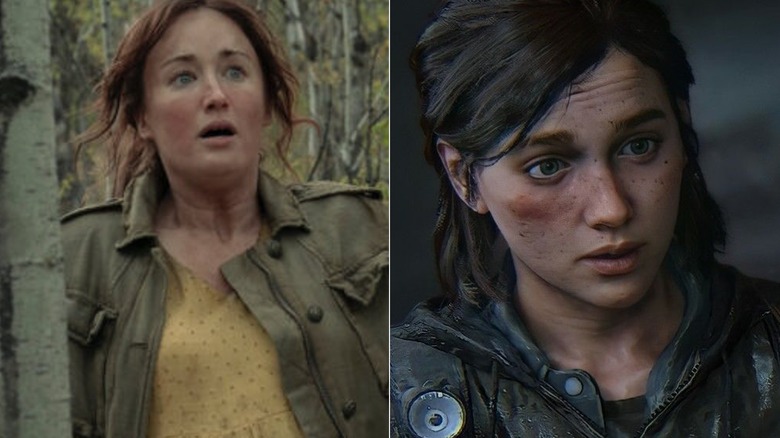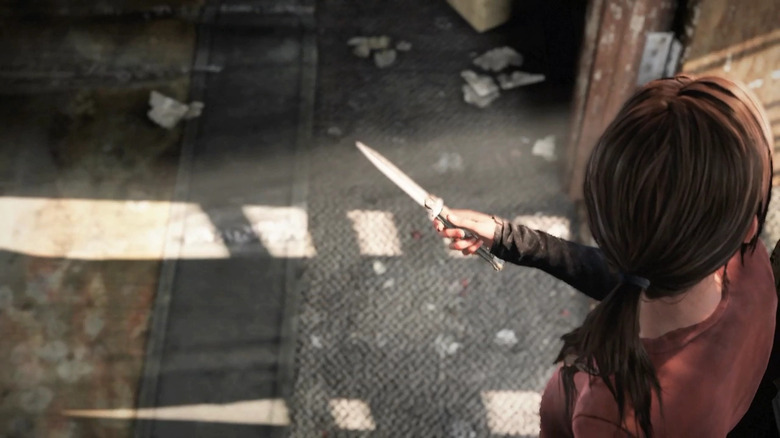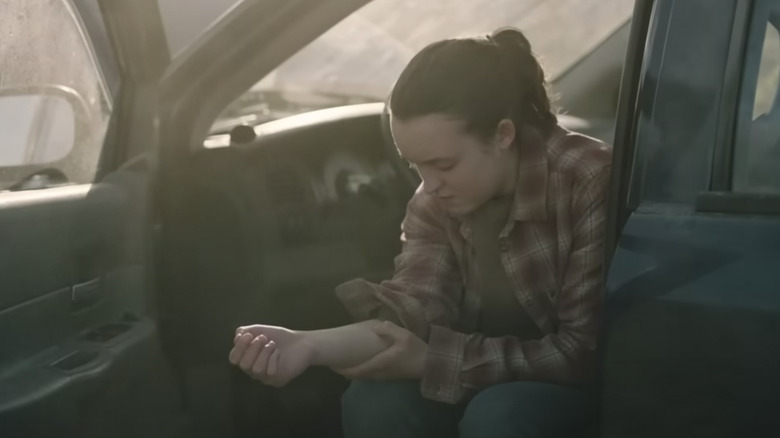Easter Eggs You Missed In The Last Of Us Season 1
A decade after the release of "The Last of Us" on PlayStation 3, video game developer Naughty Dog has joined forces with HBO to adapt the beloved post-apocalyptic survival story for television. The result is a nine-episode season that, while staying true to the heart and soul of the original video game, has forged its own identity with an incredible cast and a dazzling adaptation of the game's beloved characters and storylines.
Pedro Pascal and Bella Ramsey, who play the game's original protagonists Joel and Ellie, have a deep chemistry that brings the characters to life while taking notes from Troy Baker and Ashley Johnson, who voiced the characters in the video game. Joel and Ellie survive together across two games, as the Cordyceps brain infection ravages mankind and spawns numerous types of infected creatures, like Clickers, Runners, Stalkers, and Bloaters. Groups of people across the country make attempts to rebuild civilization, but without a vaccine, true peace might be impossible.
As the show cannot reach the same scope of storytelling that the video game did, a lot of scenes didn't make it into the adaptation. In turn, creators Neil Druckmann and Craig Mazin have cleverly thrown nods to moments in the games into certain scenes from the series. The story moves quickly, so there are bound to be some moments or details you didn't catch. To keep you up to speed, here are the Easter eggs you might have missed in Season 1 of "The Last of Us."
Spoilers for the show and games ahead.
Sarah's Halican Drops t-shirt
In the prologue of the original video game, players control Joel's daughter Sarah until her untimely death at the hands of a soldier ordered to shoot the two characters. Many of Sarah's actions in Episode 1 make serious callbacks to the video game, such as having Joel's broken watch repaired and starting out alone as the outbreak gets closer and closer to home. However, perhaps the most significant callback comes in the form of an Easter egg that reveals itself when we see Sarah (Nico Parker) wearing a purple Halican Drops band tee, much like her character did in the video game.
Missing from her outfit in the show are the long black sleeves, but the costume department made sure to include Sarah's beaded shark tooth necklace. The writers took some liberties in expanding on Sarah's experience during the final hours of Outbreak Day, like having her check in on her and Joel's neighbor Connie, who has been infected and is found tearing her caregivers apart, but the faithful inclusion of her clothing is a great touch that all die-hard "The Last of Us" fans are sure to notice.
Curtis and Viper 2
In "The Last of Us Part 2," Ellie mentions to her girlfriend Dina that Joel's favorite movie franchise is the fictional "Curtis and Viper." While on patrol together, Ellie plans to begin the process of reconciling with Joel by watching "Curtis and Viper 2" together after their day of work is finished. Later in the game, while taking shelter with Dina and Jesse in a Seattle theater, Ellie notices a "Curtis and Viper 4" poster on the wall in one of the back rooms and makes a comment to herself that it was one of Joel's favorites.
In the show, fans will notice that the DVD Sarah gifts to Joel on his birthday is "Curtis and Viper 2," a film that obviously holds importance in their relationship. This Easter egg makes the impact the franchise has on Ellie and Joel in the video game much more dynamic, as it emphasizes what Ellie means to Joel and how she has become a surrogate daughter to him after Sarah's death. Joel is eventually willing to share his interests with Ellie — interests that he once shared with Sarah, whose absence he felt so much that he could barely talk about her in the original "The Last of Us."
Joel's birthday card
When players wake up as Sarah in the video game, they have the option to pick up a birthday card in her bedroom. She mentions that she forgot to give the card to her dad but is quickly interrupted by the cataclysmic noises unfolding outside and his strange absence from their house. The card reads "Congratulations!" and features an illustration of a green cartoon dinosaur wearing a party hat.
In the show, there is a shot of Sarah's bedroom, and that same birthday card can be seen on her desk underneath some art supplies, as shared on Twitter by Naughty Dog concept artist Alexandria Neonakis. The inclusion of the art supplies in the scene could mean that Sarah went to the trouble of hand-making her father's card, something players were not made aware of while playing the game. Much like in the game, the shots of the birthday card are not lingered on for very long. Sadly, Sarah forgets to give it to Joel after gifting him his repaired watch and falling asleep while watching a movie together.
The plane crash
One of the most infamous scenes from the original game comes when Tommy, Joel, and Sarah are attempting to drive out of Austin amidst the outbreak. When they end up downtown, Tommy's truck is totaled by another vehicle as the infected attack survivors and fires break out across town, which leads to Sarah injuring her leg in the escape.
Fans were likely expecting that very same outcome to unfold, given how pivotal this event is in "The Last of Us" and the fact that the scene mirrors the perspective players experience in the game. Instead, the writers changed the layout of the scene, opting to first fake audiences out with an oncoming truck that just narrowly misses Tommy's truck.
The chaos that flips Tommy's truck in the show does not stem from another road-bound vehicle. Instead, a plane crashes in close proximity to Tommy, Joel, and Sarah, which leads to debris flying at the truck and causing it to crash. The set-up provided a great Easter egg for fans, while the switch-up gave the scene a fresh take in an episode that remained heavily faithful to the original game.
Joel's love of coffee
Early in Episode 1, Sarah makes an attempt to get Joel to drink some orange juice at breakfast. Instead, Joel declares that he would rather have a cup of coffee. At first, this might seem like some casual dialogue that is right in line with something a single father would say. In actuality, the line holds a lot of weight in the context of the franchise and hints at a conversation Joel and Ellie have together as they navigate the dystopian countryside in search of the Fireflies in "The Last of Us."
In that game, Joel confides in Ellie that he loves coffee and used to frequent coffee shops. It doesn't go beyond that until "The Last of Us Part 2," when Ellie tells Dina that Joel would sell half of his belongings for a bag of coffee beans. In Joel's house, Ellie examines his coffee cup while going through the rest of his things after his death. At the end of the game, when we watch Ellie and Joel's final conversation, he mentions that he traded an embarrassing amount of stuff for some beans.
Most importantly, at Ellie and Dina's farmhouse, there is a can of coffee beans on their counter, even though both characters have expressed a distaste for the beverage. Whether or not this can was once Joel's is still unknown, but it's clear that his love for the drink affected Ellie greatly, especially after his death. As such, this early Easter egg of him discussing his preference for coffee with Sarah is a nice, subtle touch by the writers.
Finding breadcrumbs
The world of "The Last of Us" is plunged into chaos after the cordyceps fungal outbreak. In the game, it begins with infected crops in South America. However, the show takes one of the main sources of the spread — spores — and substitutes them with tendrils that grow out of the infected. Without spores or contaminated crops, there must be some explanation for how cordyceps took over the world. On Reddit, u/anagnost suggests one possible answer — flour.
There are many hints that indicate that flour could be the cause. As noted on Reddit, Joel and Sarah manage to avoid eating flour-based products at least four different times in Episode 1. First, they find they have run out of it at breakfast and make eggs instead of pancakes. Later, they politely decline when their neighbors offer them biscuits. After that, Sarah and Connie bake cookies together, but Sarah doesn't take any because they have raisins in them. Finally, Joel forgets to pick up his birthday cake after work.
Beyond that, the creators of the show may have hinted at this in "The Last of Us Podcast." There, Craig Mazin mentions that "careful viewers of this episode will be rewarded repeatedly because little bits of breadcrumbs have been planted that are going to pay off later in interesting ways." Fans will just have to wait and see how these enigmatic hints play out in future episodes of "The Last of Us."
Joel's watch
One of the most important images from the original game is Joel's broken watch. When we meet him and his daughter Sarah, she gives him a brand new watch for his birthday, which also happens to coincide with Outbreak Day. During the course of the night, as Joel, Tommy, and Sarah navigate downtown Austin, which has fallen to chaos and panic, Joel breaks his watch. Some 20 years later, our anti-hero is still wearing that watch, which Ellie points out is broken.
In the show, Joel's watch is front and center in Episode 1. It's no longer a new gift but something that Joel has owned for a long time, even though he doesn't wear it anymore because it's broken. On top of that, the watch has become an even bigger piece of the story than before. We watch Sarah (Nico Parker) head into the city after school to get the watch repaired, which leads us to a growing suspicion that something isn't right. A pair of ambulances rush by the repair shop, hinting at the desolation that will boil over soon. When the shop owner's wife kicks Sarah out, it only confirms that the end of modern civilization is on the horizon.
A dead neighbor
In the game, players are introduced to the terror of the Cordyceps virus when Joel is forced to shoot and kill his and Sarah's infected neighbor, Jimmy, who tries to attack them near the back porch. After Jimmy's death, Sarah goes into shock, unable to comprehend how her father could kill the man she talked to just that morning. Things play out a bit differently on the show, as the infected neighbor is Connie, an elderly woman looked after by Mrs. Adler.
It's established through dialogue that Sarah visits Connie after school from time to time. The whole sequence is a subtle nod that lovers of the original game will recognize. The pandemic begins right near Joel and Sarah's home, showcasing that the terror has made its way from downtown to the suburbs. When Sarah visits Connie and Mrs. Adler, you can see Connie struggling in the background as Sarah peruses a shelf of DVDs. She twitches with her mouth agape, conjuring an eerie and silently terrifying moment that Sarah has no knowledge of. When she returns later that night, she finds an infected Connie eating her caretakers alive.
Killing infected humans
It's no surprise that FEDRA agents, in an attempt to control the spread of Cordyceps, kill any infected people they find. They can be ruthless and unwavering in their executions. In the game, as Joel and Tess (Anna Torv) are walking towards one of the quarantine zone gates, you can stop and watch four people being tested for infection. One of them registers a positive result and is immediately injected with a fatal dose of poison, while another tries to run and is shot and killed on sight.
In the show, after the events of Outbreak Day unfold, we are welcomed to the present day by a young boy wandering into the Boston quarantine zone. He is taken in by FEDRA and comforted by an agent who promises to get him his favorite meal and some toys to play with. Another agent tests him for Cordyceps and the results register positive. In one swift action, the agent injects the boy with poison, and the camera cuts away. It's an Easter egg that serves as a reminder that if you become infected, there's no way around your imminent death.
When you're lost in the darkness
One thing becomes clear early in the original "The Last of Us" — Joel hates the Fireflies. His animosity towards the group began when his brother Tommy abandoned him in Boston to join the militant group, and now Joel believes their mission to save the world and find a cure is a hopeless cause that does more harm than good.
In Episode 1, Joel stands in the distance while Tess makes a deal with someone in the slums of the Boston quarantine zone. A stranger approaches Joel and says, "If you're feeling lost," but Joel quickly cuts him off, knowing that the man is merely trying to recruit new people for the Fireflies. "If you tell me to look for the light, I'll break your jaw," Joel tells him.
The Fireflies have one slogan, which is, "When you're lost in the darkness, look for the light." The series includes shots of FEDRA agents fighting with Fireflies, as well as local workers painting over Firefly logos across the city. This interaction helps establish Joel's character and the dialogue is a subtle Easter egg that calls back to his continued distrust in the battalion that claims they can save humanity if enough people join them in their mission.
No cure in sight
The biggest overarching conflict in "The Last of Us" is the ongoing search for a cure to save mankind. The Fireflies, a militant group defecting from the tyrannical rule of FEDRA, have made it their mission to save the world and develop a vaccine. In turn, Ellie, who was bitten by an infected person but never turned, is thought to be the answer to 20 years of suffering, brutality, and death.
In the opening credits of the game, players are introduced to a montage of clips detailing what transpired in the 20 years that passed after Outbreak Day. Among those moments is an announcement from the World Health Organization that they tried, and failed, to find a cure. In the show, Episode 2 begins with Dr. Ibu Ratna analyzing the Cordyceps fungus on a victim's brain in Indonesia.
She quickly realizes that there is no cure for the virus and informs a military officer that the best option moving forward is to bomb any city that has been greatly impacted by infection. "There is no medicine. There is no vaccine," Ratna tells the officer. It's a great nod to both the dead-end quest to save the planet by the hopeful Fireflies — as well as the ruins of bombed quarantine zones that fill the game.
Butterflies
When Ellie awakens at the beginning of Episode 2, a butterfly hovers above her. This is a direct callback to various scenes in the original game, where Ellie is constantly enamored by the beauty of the butterflies and fireflies living outside of the quarantine zone. Butterflies become a symbol of hope, which mirrors the hope that the Fireflies have in Ellie's resistance to the Cordyceps virus — which they think may hold the key to producing a viable vaccine.
In the scenes where Ellie is distracted by flying insects, there is a theme of innocence at play as well. Any child born after Outbreak Day is brought into a world of immense violence and cruelty. When Ellie is falling in love with nature, taking the time to read comic books, or cracking jokes about the adults, it's a reminder that she's still just a kid trying to piece together some semblance of fun amid a hollow and deadly reality. On top of all of that, before the events of "The Last of Us Part 2," Ellie gets a tattoo of a butterfly to cover up her bite scar.
Ellie can't swim
In the original game, it's a running joke — and nuisance — that Ellie can't swim. In numerous missions, Joel is forced to push Ellie across bodies of water using a wooden pallet. In "The Last of Us Part 2," flashbacks show that Joel teaches her to swim and she actually becomes quite skilled at it. She even gets good enough to make a joke about her past shortcomings when the two encounter a stray pallet near a museum in Wyoming.
When Joel, Tess, and Ellie reach the hotel in Boston, there is a lot of water separating them and the stairwell they need to get to. Quickly, Ellie notes that she can't swim because there aren't many pools in the quarantine zone. Annoyed by her point, Joel shows Ellie that the water only goes up to his knees. It remains to be seen whether or not Ellie's inability to swim will become as big of a plot point in the show as it was in the game — or if pallets will ever come into play. For now, this moment between her and Joel is an effective way for the show to communicate the burden Joel believes Ellie is to him.
Collapsed skyscrapers
One of the first missions in the original game that truly evokes fear comes when Joel, Tess, and Ellie are tasked with entering a crumbling building to get closer to the Capitol, where Fireflies are waiting for them. Across numerous stories in the building, each player must battle against the infected while moving quickly enough to avoid any serious structural collapse.
Series creators Neil Druckmann and Craig Mazin have opted not to include those scenes in the early episodes of the show, most likely so the focus on Joel and Ellie's story doesn't get watered down with unnecessary action. Through the first four episodes, the showrunners have elected to give more innocence to Ellie and, in turn, keep her away from combat. It's a subtle choice that keeps the pacing of the show intact.
However, in place of these memorable sequences from the original game, the show offers compelling and powerful shots of skyscrapers collapsing into each other. It portrays the fallout from the government's quarantine zone bombings and conjures an unforgettable image that speaks to the desolation survivors must endure.
Ellie's sexuality
While the 2013 video game "The Last of Us" does not contain get any explicit references to Ellie being a lesbian — given that she's only 14 years old at the time — the DLC content "The Last of Us: Left Behind" does explore this aspect of her character. There, she shares a passionate kiss with her best friend Riley while they dance to a cover of "I Got You Babe" by Etta James. It's not until "The Last of Us Part 2" that players get an actual confirmation of Ellie's sexuality, as she starts a relationship with another woman, Dina, in Jackson, Wyoming.
In Episode 2 of the HBO series, Joel, Tess, and Ellie cross a bridge together in Boston. To pass the time, the three discuss the history of the Boston quarantine zone and Ellie's experience of getting bitten. Eventually, Tess asks Ellie if someone will be coming after her, like her parents — or a boyfriend. Ellie replies, "I'm an orphan and, uh, no."
How the show will handle her growing independence remains to be seen, but Tess' question and Ellie's evasive answer are a nice nod to something that becomes an important part of Ellie's story, especially in the second game.
A hopeful view
One thing "The Last of Us" doesn't have nearly enough of is hope. After all, it's hard to conjure much positivity when the world around you is so bleak. In the game, as Joel and Ellie are about to reach the hospital in Salt Lake City where the Fireflies are stationed, they stumble upon a tower of giraffes in an open field. It's one of the most beautiful and enchanting parts of the first game, and it gives the player a break from the never-ending brutality — even if it does lead to some unanswered questions. Players can stand at the ledge and watch the giraffes for as long as they'd like. The game never forces the protagonists to move on, which adds to the sadness of Joel and Ellie's reality.
In Episode 2 of the show, as Joel, Tess, and Ellie are traveling across Boston and heading toward the Capitol building, they stop and take in the sights from a rooftop. "You can't deny that view," Ellie says to Joel, foreshadowing their moment in Utah together months later. Despite the ruins splayed out before them, the horizon line sits aglow. Fragments of Gustavo Santaolalla's "Vanishing Grace (Childhood)" — the same composition that soundtracked the giraffe encounter in the game — sputter in the background, fully cementing the nod to this memorable moment from the original game.
Bill's traps
In the game, Joel and Ellie spend a good amount of time in Bill's town, where they hope to obtain a car that will help get them to Tommy in Wyoming. One of the most memorable parts of the chapter set in Bill's town is just how many traps he has set up in every corridor, such as his explosive trip wires. However, none of the key scenes that occur between Joel, Ellie, and Bill in the game are recreated in the early episodes of the show. Instead, we get almost an entire episode dedicated to Bill's life in his desolate town, where we get to see some of the traps Bill depends on adapted for the series.
Bill meets his future husband Frank (Murray Bartlett) in Episode 3, who stumbles onto his property and falls into a giant hole in the ground. Bordering his house is an electric fence powered by generators, and he has cameras set up everywhere so he can keep tabs on all who lurk beyond his front door. Later in the episode, when Frank and Bill have an argument, the former threatens to run through one of the latter's tripwires. The only time we see one of those tripwires is while Bill is eating dinner alone and an infected man walks right into one, meeting his demise from a rigged gunshot to the temple.
Ellie and video games
In the DLC add-on "The Last of Us: Left Behind," Ellie and Riley find Raja's Arcade in the abandoned Liberty Gardens mall in the Boston quarantine zone. While inside, they stumble upon an array of arcade games that don't work. Ellie is particularly drawn to "The Turning," a fighting game. In one of the most touching moments of the chapter, Riley narrates the game for Ellie, who pretends to use the buttons as if they were actively working.
In Episode 3 of the show, Joel and Ellie come upon an out-of-order "Mortal Kombat" arcade game in an abandoned store. Ellie, albeit vaguely, reminisces about her time with Riley in the arcade. It's a quick but sweet moment that alludes to a flashback that will likely come later in the season, where Riley and Ellie spend time together in the abandoned mall. Whether or not the game that gets featured in the flashbacks will be "The Turning," "Triple Phoenix," or something entirely different remains to be seen, but this subtle callback to a beloved moment from the DLC is a great Easter egg.
Ellie's pun book
In Episode 4, after Joel and Ellie have left Bill's (Nick Offerman) town, Ellie begins reading jokes from her book, "No Pun Intended: Volume Too," much to Joel's dismay. The importance of Ellie's pun book in the video games is immense, as it was gifted to Ellie by her best friend Riley after they sneak into the abandoned mall together in the DLC content "The Last of Us: Left Behind." The book is one of Ellie's few possessions — aside from her infamous switchblade and backpack — so it's refreshing to see her using it during the show.
Many of the Easter eggs hidden across episodes of the show are not as direct as this one. We get a good shot of the cover, and the puns become one of the first things Ellie and Joel share a good moment over. Not only is it a great nod to this beloved DLC content, but it also foreshadows future flashbacks of Ellie and Riley, which are pivotal in Ellie's coming-of-age story and her relationship with the Cordyceps virus.
Alone and Forsaken
After leaving Bill's town in a truck, Ellie reveals to Joel that she lifted a cassette tape from his home. The song that plays is "Alone and Forsaken" by Hank Williams, a song that Joel lovingly calls a "winner." This scene unfolds exactly as it does in the game, dialogue and all. There are a lot of moments in the show that get tweaked, shortened, or left out altogether, but this across intact. The song choice is important because it's also the name of a crucial chapter in the game where Joel and Ellie encounter a murderous gang in Pittsburgh. In fact, the song was even used in the first trailer leading up to the show's release.
The lyrics tell a story of love that quickly turns dark. The protagonist meets his lover when "the pastures were green and the meadows were gold," but their story quickly turns somber as the narrator is abandoned. The song could be meant to symbolize Tess and Joel's relationship, which they began as prosperous smugglers only to end in death. More than likely, though, it's meant to symbolize the momentary hope that Joel feels as he and Ellie head to Wyoming. They've just secured a working truck, but things quickly turn grim once they are hunted across Pittsburgh by the gang lording over the city.
Long, Long Time by Linda Ronstadt
Song choices across the two games are essential to the themes in the series overall. "Future Days" by Pearl Jam, "Take On Me" by a-ha, and "Helplessly Hoping" by Crosby, Stills, & Nash all soundtrack key moments in "The Last of Us" and "The Last of Us Part 2." Linda Ronstadt's 1970 song "Long, Long Time" can be added to that list now, too.
After Bill and Frank share a dinner together, Frank gravitates toward a piano in Bill's living room. He finds some sheet music for Linda Ronstadt's greatest hits and begins playing "Long, Long Time." After taking turns singing the song, Bill and Frank embrace in a passionate kiss — although the song signals an even deeper connection to the world of "The Last of Us."
Ronstadt's lyrics for the chorus of this classic song read, "Cause I've done everything I know to try and make you mine, and I think it's gonna hurt me for a long, long time." The lyrics could be a nod to Joel and Ellie's relationship, foreshadowing the immense guilt Joel lives with after the events seen in the ending of the original "The Last of Us," when he elected to save Ellie instead of letting her die — even though her death may have lead to a cure.
The tunnels
A major part of the first game follows Joel, Ellie, Henry, and Sam as they explore the sewer tunnels that run beneath Pittsburgh. In the show, the location has been changed to Kansas City, and the tunnels are called "maintenance tunnels" by Henry (Lamar Johnson). The chapter in the game takes a long time, as the four characters must fight against a battalion of infected while they learn about the small community that once lived underground.
In the show, fans of the game are rewarded with a great scene in which the characters discover a familiarly colorful room with books, toys, and drawings everywhere. Taped to the wall is a drawing of two men labeled "Danny" and "Ish" that reads "our protectors" beneath them. Through recovering artifacts and notes in the game, you learn that Ish was a sea captain who built a safe house in the Pittsburgh sewers. Over the years, more and more people joined him, including Danny, who helped acquire guns and gear to fend off the infected — or healthy trespassers.
Ellie plays soccer with Sam (Keivonn Woodard), much like they do in the game. In the show, the tunnels become Joel, Ellie, Henry, and Sam's saving grace, as a swarm of infected, including an unkillable Bloater, wipe out the Kansas City rebels hunting them. Some of the infected are children, which could mean that they were once a part of the community led by Danny and Ish.
Savage Starlight
In the first game, players can collect different types of artifacts, like Firefly pendants. When playing as Joel, you stumble upon various issues of the comic book series "Savage Starlight," which players collect to give to Ellie. In "The Last of Us Part 2," Ellie then begins collecting trading cards based on "Savage Starlight." While in the kids' room of the tunnel hideout, Ellie and Sam discover the comic and read it together.
Centered around the protagonist Dr. Daniela Star, "Savage Starlight" becomes a beacon of truth for Ellie, who is looking for meaning after losing almost everyone she cares about. Her own personal motto comes from the books — "Endure and survive." That quote gets a cheeky jab from Joel later in Episode 5, but it becomes a small token of love between Ellie and Sam in the show.
Throughout the episode, Ellie acts out the sound effects from the comic's pages for Sam, which brings him some joy and laughter, which Henry says he hasn't seen from him in a long time. There are 14 different comics to collect in the game, which, once completed, gives players the Endure and Survive trophy. In the second game, Joel attempts to bond over "Savage Starlight" with Ellie, making her time reading it with Sam in the show all the more heartwarming.
Jeffrey Pierce
It's already been confirmed that Troy Baker and Ashley Johnson, who voiced Joel and Ellie in the video games, will have roles later in Season 1. However, they aren't the only veterans from the games to make appearances in the show. We already saw Merle Dandridge reprise her role as Marlene in the pilot. In Episode 4, we met a soldier in Kathleen's (Melanie Lynskey) revolutionary army. Perry, played by Jeffrey Pierce, might not have a familiar face to "The Last of Us" fans, but his voice might ring a bell.
In both games, Pierce provided the voice of Tommy, Joel's younger brother. Though Tommy — as played by Gabriel Luna — has only been in one episode of the show so far, his role in Joel's quest is more important than ever, as his disappearance has been given a bigger emphasis in the HBO series. Having Pierce step in and be part of what's slowing Joel's western migration down was a great touch, as has been seeing Naughty Dog bring these important voices from the games back for the show. In Pierce's case, his new character got to go out in a pretty cool way — getting decapitated by a Bloater.
Ellie dreams of space
A recurring motif in the second game is Ellie's love for outer space. There is a scene that she and Joel share in "The Last of Us Part II," via a flashback, where he takes her to a museum in Wyoming to see a space exhibit. He even gifts her a cassette tape with the audio from the Apollo space shuttle launch recorded onto it and a rocket ship pin from the museum's gift shop. At another point in the game, Ellie tells Dina that she wants to become an astronaut someday.
In the show, while discussing their dreams, Ellie mentions to Joel that all she's ever been surrounded by was an ocean and a fence, so she was forced to look upwards at the sky. In turn, she hopes to go to the moon one day. Ellie's dreams of space and the unknown are particularly touching in both versions of "The Last of Us," as they help maintain some youthful innocence for her, especially in a world wrought with affliction, violence, and cruelty.
Joel wants to raise sheep
While Joel and Ellie are camped out in a cave just outside of Jackson Hole, Joel shares with her that, after their trip is all said and done, he'd like to raise sheep on a farm. It's one of the first times we get to see Joel open up in the show, despite the fact that he has spent months traveling across the country with Ellie at this point. His vulnerability has blossomed since the pilot episode, and it showcases that his bond with Ellie continues to grow deeper.
Though a future of farming never comes in the game for Joel, that outcome does happen for Ellie. After she and Dina are almost killed by Abby in the second game, the two characters decamp to a rural area just outside of Jackson and live in a farmhouse together. On the property there's a flock of sheep that they care for. Joel mentioning wanting to do this is a lovely, subtle nod to Ellie's future, one where she struggles with PTSD after watching him get murdered.
Dina
One of the biggest parts of "The Last of Us Part II" is Ellie's relationship with Dina, a girl her age who came to Jackson before her and Joel. In the first game, Dina doesn't make any appearances and is never mentioned, but it's quite possible that we got to see the future main character briefly in Episode 6. After arriving in Jackson, Ellie and Joel are given a meal from Tommy and Maria (Rutina Wesley). While she's eating, Ellie yells at a girl lurking behind a banister in the dining hall.
The girl looks like Dina, and the interaction parallels a conversation she has with Ellie in the second game, when they reminisce on Ellie first getting to Jackson: "I was overwhelmed by all the food. I remember my first week just gorging myself. Stuffing food in all my pockets for later like it was gonna run out," Ellie said. "I saw that!" Dina replied. It hasn't been confirmed yet whether or not the girl was Dina, but, knowing how well Druckmann and Mazin have sprinkled Easter eggs into the plot, it likely was her.
Shimmer
While touring Jackson, Maria takes Ellie and Joel to the stables, where they get to meet a foal that goes by the name of Shimmer. Fans of the games surely perked their heads up at that detail, as Shimmer is the horse that Dina and Ellie take when they go to Seattle to find Abby and the WLFs that killed Joel. When we meet Shimmer in the game, she's a fully grown horse, so getting to see her as a youngling is a sweet touch.
Episode 6 is littered with nods to "The Last of Us Part II" — players didn't get to see the city of Jackson until the second game. Putting Jackson into the timeline of the first game's events only emphasizes how important it will be in Season 2 of the show. Those familiar with the franchise were probably not expecting a cameo from Shimmer so soon, but it's a great touch from the writers, as fans no doubt smiled ear-to-ear once they heard the name.
The giraffe poster
One of the most beloved symbols in "The Last of Us" is a giraffe. When Joel and Ellie pet and watch giraffes from a rooftop in Salt Lake City, it became a pivotal moment between the two characters, signaling a change in Joel's destiny. It was then that he decided he would do everything in his power to keep Ellie safe for the rest of his life.
In the show, when Ellie and Joel have their argument in Ellie's bedroom (a word-for-word recreation of the original scene in the game), a giraffe poster is on the wall behind Joel. And, much like the giraffe scene in the first game, this moment is monumental for their relationship. It's the turning point in Joel's heart, where he decides that, even though he couldn't save Sarah, he can save Ellie instead.
There was already a stuffed giraffe briefly shown earlier in the season, and the animal is bound to keep appearing throughout the rest of the show. But the placement of this poster is a great Easter egg that will hold much importance in the hearts of fans, especially those who have been waiting for this climactic scene all season.
Ellie's cassette tapes/Take On Me
Early in the episode, as Ellie is about to go to bed at FEDRA school, there is a quick shot of a stack of cassette tapes on her desk. On top, we see A-ha's greatest hits compilation. Beneath it, there's an Etta James album. Both are Easter eggs that continue to get fleshed out across the entire episode. On top of that, cassette tapes play a big part in Ellie's interests in "The Last of Us Part II," as she often carries a Walkman around with her.
After Riley (Storm Reid) takes Ellie into the abandoned mall, Ellie marvels at the wonders of a working escalator. What's playing in the background? A-Ha's seminal hit song, "Take On Me." Fans of "The Last of Us Part II" will recognize the significance of the famous song right away, as, in the game, Ellie plays an acoustic rendition of the song to Dina in the music store in Seattle. The song is an important piece of Dina and Ellie's relationship, and the showrunners opted to bridge that into Riley and Ellie's relationship, too.
Just like in the first game, Ellie and Riley dance and kiss to Etta James' "I Got You Babe." That song choice was likely always going to find its way into "Left Behind," but seeing it subtly hinted at early in the episode is a nice touch.
Flashlight shake
Before "The Last of Us" began, there were questions about how combat sequences and little game quirks would be translated into a television script. While it was shown in Episode 1 that the superhuman agility and power of infected people were nerfed with them being clumsy, one recurring detail from the gameplay made its way into Episode 7.
As Riley and Ellie are making their way into the abandoned mall, Ellie's flashlight starts flickering uncontrollably, to which Riley asserts that Firefly flashlights are better. Savvy game players will be delighted to see Ellie shake her flashlight to get it working again, much like the player would in the game. Whenever a flashlight would start to go bad in the game, players would have to hit the bottom of their controller against their palm, leg, or lap.
Obviously, that kind of player-based procedure wouldn't work well in the show. Luckily, Druckmann and Mazin found a clever way to insert unique game moments into the narrative, ones that would otherwise be overlooked in favor of richer plot points.
Dawn of the Wolf Part II
As Riley and Ellie make their way through the abandoned mall, there is a shot of a movie poster, "Dawn of the Wolf Part II." It is no secret that most of the movie titles in the game and show are fake, and "Dawn of the Wolf" is no different. However, this one is especially focal on Joel's character. In the game, he reveals that "Dawn of the Wolf" was one of the last movies he and Sarah watched together. She dragged him to the theater to see it, much to his own dismay. There are a few times in the game when the poster appears.
"Dawn of the Wolf" is "The Last of Us" universe's version of "Twilight," as Joel asserts that it's just another "dumb teen movie" when Ellie asks if the main character gets "gutted" at the end. When "The Last of Us" was being developed by Naughty Dog, "Twilight" was one of the biggest movie franchises in the world. It's a silly joke that, even in a post-apocalyptic world, melodramatic teen movies still remain. But, unlike "Twilight" and its five installments, "Dawn of the Wolf" was limited to just two entries before the world fell apart.
Ellie's room decor
The first part of Episode 7 has a great scene between Ellie and Riley, the latter of whom has been missing for three weeks after running away from FEDRA school and joining the Fireflies. Before Riley returns, we get a lot of great Easter eggs and nods to other parts of the game (and show) via what's in Ellie's room.
On the walls, there are numerous space-themed posters, including one of the moon, and a "Mortal Kombat II" poster, an interest hinted at by Ellie in Episode 3 that will fully come to fruition later in Episode 7. There's a picture of a giraffe in there, as well as a plethora of "Savage Starlight" comic books, one of which Ellie reads before bed. On her bedside table, too, is Will Livingston's "No Pun Intended Vol. 1." We got to see Ellie reading from "Volume Too" earlier in the season, and it is Episode 7 where we learn that it was Riley who gifted her the beloved second edition.
There are also dinosaur drawings, a hint to a quick moment later in the episode, and a major story in "The Last of Us Part II." Ellie's bedroom is like a kaleidoscope of all of the things viewers and players have come to understand about her character. It's like a time capsule, one that she ultimately had to leave behind after getting bit in the abandoned mall with Riley.
Is it a dinosaur?
Another callback to "The Last of Us Part II" is one that happens so fast you might have missed it. When Riley reveals that she has a gift for Ellie, Ellie quickly begins a rapid-fire interrogation of Riley, begging to know what the gift is. At the end of her rambling, she offers a final question: "Is it a dinosaur?"
Fans of "The Last of Us Part II" will remember that, during the first major flashback in the game, Joel takes Ellie to a surprise location for her birthday. Joel won't budge on it, even though Ellie berates him with never-ending questions. She asks him: "Is it a dinosaur?" And then, to her excitement, it is. Well, technically. Joel takes Ellie to the Wyoming Museum of Science and History, which has a large, full-scale statue of a Tyrannosaurus Rex outside.
A dinosaur exhibit is one of the main parts of the museum, along with the infamous outer space area. Ellie takes out her journal and writes notes about every species of dinosaur she learns about, and she and Joel have a hilarious conversation about "Jurassic Park 2." This quick line of dialogue in the show is a great touch that will have die-hard fans glowing.
Troy Baker
Jeffrey Pierce and Merle Dandridge are not the only voice actors who worked on the games to make an appearance in the HBO show. In Episode 8, Troy Baker plays James, one of David's (Scott Shepherd) band of cannibals. Baker's voice and face might not be immediately familiar, especially to viewers who have never played the games, but he's an essential part of the franchise. In both games, Baker provides the voice and motion capture for Joel, and his performances helped make the games a success.
As James, we see Baker honing his live-action acting chops by questioning David's decisions regarding Ellie. James wants vengeance for Joel killing a member of their crew, but David elects to keep Ellie alive. Baker was thrilled when the creators of the show told him about the role they had in mind for him. "I thought I was gonna get a walk-on role. And then I got the script, and I was like, 'Oh, there's meat here.' Pardon the pun," he told Variety. "For me, the challenge was apparent: I don't want to play a villain. So how do I make this guy not a villain? And to me, we're all the heroes of our own story. To me, we're experiencing James' story."
Pittsburgh
One of the biggest changes in HBO's adaptation of "The Last of Us" is the location where Joel and Ellie meet Henry and Sam. In the game, the meeting takes place in Pittsburgh, but in the show, it's changed to Kansas City. Moving the location doesn't have a huge impact on the narrative, save for how Pittsburgh's yellow bridges were used as a beacon of direction for Ellie and Joel in the game. However, Pittsburgh does not get thrown to the curb entirely in the show.
In Episode 8, Ellie and David take shelter together in a rundown barn. David tells Ellie that he was part of the Pittsburgh quarantine zone until it fell out of FEDRA's control. Viewers who haven't played the game won't pick up on the significance of this, but die-hard fans of the franchise will be pleased to hear Pittsburgh get a mention. David claiming that the city fell aligns with events in the canon, as Pittsburgh is overrun with hunters who rule the streets in the game.
Three kings
"The Last of Us" is famous for not having very many human antagonists. The central figure working against Ellie and Joel in the first game is David, the leader of a small community holed up in the town of Silver Lake, Colorado. Episode 8 is swarming with religious themes, but the most striking one relates to King David and his apostles.
King David was the leader of the Israeli Empire around 1000 BCE. He's remembered as a unifying figure who brought a number of tribes together. He's also said to have taken many wives, creating a harem. In "The Last of Us," it's probably not a coincidence that David is the leader of a religious group. When talking about his cause with Ellie, he even goes as far as calling himself a "shepherd" and labels everyone else his "sheep."
David refers to himself as a father to the women in his group, but, through his actions in Episode 8, it can be inferred that he abuses his power for sexual purposes. Some of David's followers also serve as religious Easter eggs: His closest confidants are named James and Josiah, two prominent kings in their own right.
If you or anyone you know has been a victim of sexual assault, help is available. Visit the Rape, Abuse & Incest National Network website or contact RAINN's National Helpline at 1-800-656-HOPE (4673).
When we are in need, he shall provide
When we first meet David in Episode 8, he is giving a sermon to the people of his community. Above him is a banner that reads: "When we are in need, he shall provide." This same banner hangs in the burning restaurant in the first game.
The banner plays a part in the story in two ways: The "He" in question at Silver Lake is David, who sees himself as a God-like figure, which is why he refers to himself as the group's father. When a young woman named Hannah (Sonia Maria Chirila) questions his decision to let Ellie live even though Joel killed her father, David hits her and tells her that she is not without a father, referring to himself.
From Ellie's point-of-view, the "He" who provides is Joel, but, because of his infection, he is bed-ridden and can't help her. As a result, Ellie must take care of him, a 180-degree turn from where the two characters are in Episode 1. It's fitting that David's demise comes because he christens himself the sole provider of his people. On the flipside, Ellie and Joel continue to survive by saving each other and becoming more equal over time.
Ashley Johnson
The last cameo of Season 1 is easily the most rewarding. Though it was nice seeing Troy Baker in Episode 8 and Merle Dandridge in the pilot and finale, the last episode opens with Ashley Johnson, the voice of Ellie in the games, running into an abandoned farmhouse to get away from an infected runner. In both games, Johnson brought the character of Ellie to life. In the show, she plays a pregnant Anna, who is revealed to be Ellie's mother.
Throughout the cold open, in which Anna fights off an infected mere moments after her water breaks, hearing her talk and grunt is surreal, as it's impossible for fans of the games not to picture the digital version of Ellie each time. Anna is injured while struggling with an infected runner who follows her into the house, and Ellie is born during the struggle. Anna manages to kill the infected, but not before sustaining a bite on her inner thigh.
Baker's send-off as James was fun, but Johnson's departure from the show arrives in a much more heartbreaking way. Marlene arrives at the house and finds Anna becoming infected. After giving Ellie to a Firefly soldier, Marlene executes Anna, but not until after we learn that the two of them have known each other their entire lives and Anna asks Marlene to take care of Ellie for her.
Ellie's switchblade
There are several recognizable motifs, themes, and objects in "The Last of Us," and many of them are shown in the finale. We finally get to see the pivotal giraffe scene that has been teased all season long, and there is the harrowing final story beat when Ellie says "Okay" to Joel near Jackson. However, one instrumental weapon gets a well-earned backstory early in the episode.
At the beginning of the episode, Ellie's pregnant mother Anna fights off an infected runner with a knife. It is revealed in a close-up that that knife is actually the switchblade that Ellie has been carrying for years — a piece of information we never learn in the games as Ellie's proficiency with a knife never gets a story behind it. Here, the already iconic weapon gets the Hollywood treatment. Before Marlene executes Anna, Anna gives her her switchblade to later gift to Ellie when she's old enough.
Over the course of the two games, the one constant in Ellie's life is her switchblade. Now that we know it originally belonged to her mother, it carries even more significant weight in the franchise's lore.
Ellie's immunity
At the center of the narrative throughout "The Last of Us" is a medical marvel — Ellie's improbable immunity from Cordyceps. It's the motivation behind her and Joel's journey to Salt Lake City and the hope that holds the Fireflies' army together, as revealed in "The Last of Us Part 2." The source of Ellie's immunity is never revealed in either game, though it's implied that there is something irregular about how Cordyceps mutates on her brain, which is why the Fireflies must perform a fatal surgery on her to develop a cure.
In the finale, we learn that Ellie's immunity likely stems from the fact that she was still attached to Anna's umbilical cord when Anna was bitten by an infected runner. Though Anna lies to Marlene and claims that Ellie was born before she was attacked, it's clear that something related to Cordyceps in Anna's bloodstream was transmitted into Ellie's DNA or immune system.
After 10 years, the question of Ellie's immunity finally seems to be answered, and it gives more context to the Fireflies' belief that their doctors will be able to copy the code in Ellie's brain that prevents Cordyceps from ravaging her entire body. It complicates the discussion around whether or not a cure is even possible since fungi can't be vaccinated against. For now, the story of Ellie's immunity gets a backstory that fans have earned after a decade of speculation.
